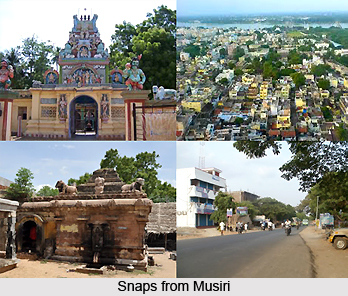 Musiri is located in Tiruchirapalli district in the Indian state of Tamil Nadu. It is a panchayat town situated 10.93 degree North latitude and 78.45 degree East longitude. The town is also a taluk and revenue division headquarters in Tiruchirappalli district. It has an average elevation of 82 metres above the sea level. An old inland port is located alongside the Kaveri River. It is also known as Pseudostomus or `one with false mouths`. Musiri is connected to the town of Kulithalai via a long bridge across the Kaveri River. The town is a separate assembly constituency that is under the Tiruchirappalli parliamentary constituency.
Musiri is located in Tiruchirapalli district in the Indian state of Tamil Nadu. It is a panchayat town situated 10.93 degree North latitude and 78.45 degree East longitude. The town is also a taluk and revenue division headquarters in Tiruchirappalli district. It has an average elevation of 82 metres above the sea level. An old inland port is located alongside the Kaveri River. It is also known as Pseudostomus or `one with false mouths`. Musiri is connected to the town of Kulithalai via a long bridge across the Kaveri River. The town is a separate assembly constituency that is under the Tiruchirappalli parliamentary constituency.
History of Musiri
According to history Musiri was earlier known as Musukundapuri. It was named after a Chola king Musukundan. The town served as an inland port of the Chera Dynasty. During the Sangam Age they reigned from Karur.
Demography of Musiri
According to the India census report of 2011 Musiri had a population of 27941. The males constitute 50% and females constitute 50% of the population. The average literacy rate of the town is 75%. It is higher than the average literacy rate of 59.5%. The male literacy rate is 80% and female literacy rate is 69%. 11% of the population is under 6 years of age in Musiri.
Economy of Musiri
The main source of income of the residents of Musiri is agriculture. Some of the important crops grown here are sugarcane, paddy, banana, coconut and vegetables. Besides this the town is also known for producing korai grass mat.
Educational Institutions of Musiri
Musiri has established several schools and colleges for imparting education. One of the important colleges here is the Educational Institution Nehru Memorial College (NMC) started in 1967. It is autonomous college affiliated under the Bhartidasan University. The college has 12 departments.
Cuisine of Musiri
Some of the popular cuisines of Musiri are idli, sambar, vadai along with parotta and kuruma. These popular dishes are all available in most the restaurants of the town.
Pilgrimage Centres in Musiri
Musiri has few prominent temples located in the town. Some of them are Angaalamman temple, Chandra Mauleeswara (Shiva) temple and three Maariyamman temples. Apart from this a church and a mosque is also located here.



















